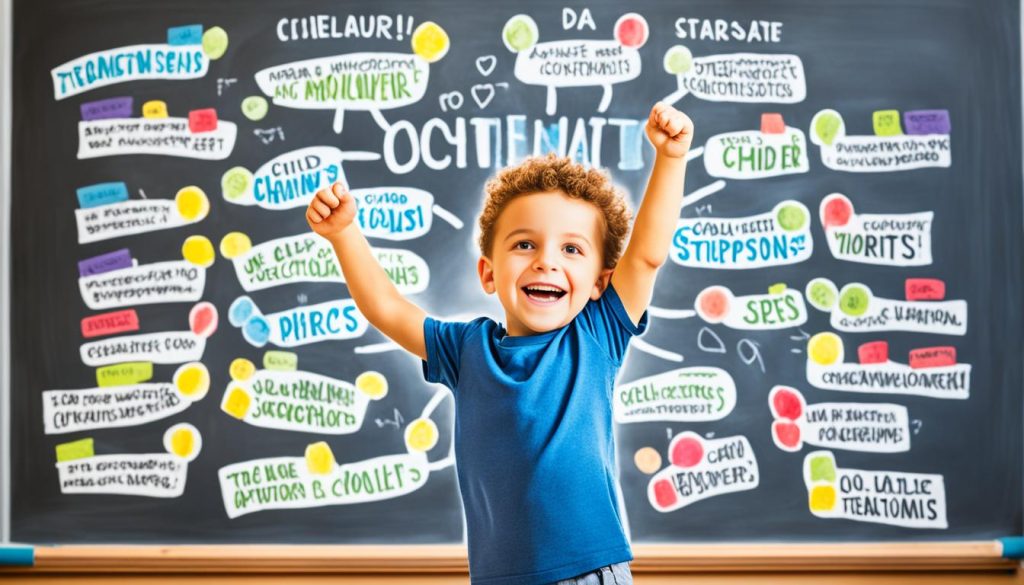Do you remember the first time you rode a bike? It was all about the wobbly balance and the thrill of moving on your own. Now, imagine sharing that feeling of achievement with your child. Parents in their 30s and 40s often want to raise kids who are independent and confident. Teaching kids to set goals is a great way to do this, helping them stay motivated for life.
About 92 percent of people don’t meet their goals, but you can teach your child to be different. Positive parenting means understanding what each child wants and values. Start by picking a “Big Goal” that matches your child’s interests. This could be doing well in a sport, playing an instrument, or getting good grades in school.
It’s important to set clear goals that can be measured. Encourage your child to make specific plans, like “I’ll review my daily class notes every week.” This way, they can see their progress and feel proud of their achievements. It helps build a habit of reaching goals.
Key Takeaways
- Positive parenting means understanding what each child needs and wants.
- Goal-setting helps kids stay motivated and independent.
- Choosing goals that match a child’s interests is key.
- Clear, specific goals help track progress and boost achievement.
- Support from parents is crucial for reaching goals.
The Importance of Goal Setting for Kids
Goal setting is key for kids. It helps them feel responsible and boosts their motivation and focus. By setting their own goals, kids are more likely to work hard to achieve them. This is vital for them to become independent.
It also helps them learn to prioritize tasks every day. This leads to a life of purpose and sets the stage for success as they grow older.

Developing Grit and Resilience
Setting and chasing goals helps kids build grit and resilience. They learn to keep going even when things get tough. This is crucial for doing well in school and in life.
Writing down goals can make achieving them 42% more likely, says Dr. Gail Matthews. Talking about goals with a parent or friend can increase this to 72%. This shows how important it is to support kids in setting goals.
To set goals well, kids should pick 2-3 things they really care about. It’s important to create a safe space for them to share their thoughts. This helps build their self-esteem.
Talking openly about important topics, like essential conversations for children, helps break down barriers. It empowers kids to make smart choices about their goals.
Teaching Responsibility and Accountability
Goal setting also teaches kids about responsibility and accountability. They feel in charge of their progress and efforts. By showing them how to be committed and on time, you help them reach their goals.
Helping kids spot and overcome obstacles is crucial for their growth. This process helps them develop social skills by working with others. Tools like Google Calendar can help them manage their time better.
Recognizing small achievements and praising their efforts, not just results, fosters a growth mindset. This encourages them to keep going for the long haul.
How to Encourage Your Child to Set Goals
Encouraging kids to set goals is key for their mental health and in today’s digital world. Helping them find and chase their dreams boosts their purpose, resilience, and creativity.

Listening to Their Interests
Listening to what your child loves is a great way to help them set goals. By focusing on their passions, you can guide them to set goals that truly matter to them. This boosts their drive from within.
Studies show that knowing the reason behind a task makes people do better. So, it’s important to listen and match goals with what they care about.
Helping Them Identify Specific, Measurable Goals
It’s important to help kids set clear, reachable goals. The SMART method (Specific, Measurable, Achievable, Relevant, Time-bound) is great for this. Writing down goals can make them 42% more likely to happen, as it makes things clear and trackable.
Setting goals gives kids a feeling of success and ability, pushing them to aim higher. Breaking big goals into smaller steps makes setting goals easier and less scary.
Using vision boards is a fun way to see their goals. It boosts creativity and keeps their dreams in sight, helping them stay focused and determined.
Integrative Measures
| Goal-Setting Method | Benefits | Implementation Strategies |
|---|---|---|
| Listening to Interests | Improved Motivation and Performance | Engage Kids in Conversations, Monitor Their Activities |
| SMART Goals | Increased Clarity and Tracking | Write Down Goals, Break into Steps |
| Vision Boards | Enhanced Creativity and Dedication | Encourage Visual Aids, Regular Review |
Identifying the “Big Goal”
Finding the “Big Goal” is key for kids to achieve their goals. It helps them connect with their true dreams and stay committed. This step builds a growth mindset for kids and teaches them about persistence and discipline. These are the basics for success throughout their lives.

Setting goals right is important. Research shows that 92% of people don’t reach their goals. This shows how crucial structure and strategy are. Using intrinsic motivation and clear goals helps kids a lot. Studies from 2014 found that knowing the reason behind learning makes students do better.
Amy Cuddy from Harvard says breaking big goals into smaller steps keeps kids motivated. Gabriele Oettingen’s work shows that thinking ahead and planning helps beat challenges. Writing down goals makes achieving them 42% more likely. Sharing goals can increase success to 72%, as Dr. Gail Matthews found.
Helping kids set their “Big Goal” means managing screen time well. This keeps them focused, which is key for reaching their goals. These methods strengthen their commitment to their dreams, fitting into lifelong learning in children.
It’s important to focus on purpose, celebrate small wins, and use positive talk with kids. Praising their effort and resilience builds a growth mindset in kids. This approach values the process over just the results.
Supporting Your Child’s Purpose
Helping your child find their purpose is key to their growth and success. When they see their goals help others, they feel more motivated and responsible. As a parent, you can help your child become more independent by guiding them towards goals that help others.
Fostering child independencestarts with showing them how their goals can make a difference. This can be through community service, helping the environment, or supporting social causes. These activities give them a sense of purpose and help them think about the impact of their actions.

Encouraging Critical Thinking
Teaching critical thinking is important for setting goals. When kids see the value of their efforts, they think more deeply about their choices. Encourage them to think about how their goals match their values and help others.
Ask them questions, talk about their interests, and let them try different things. This way, you’re teaching them responsibility and supporting their hobbies. It leads to a more fulfilling life.
The table below highlights key aspects that contribute to fostering a child’s sense of purpose and critical thinking:
| Aspect | Explanation |
|---|---|
| Exploring Passions | Encouraging children to explore a variety of activities helps them discover their passions and strengths. |
| Parental Involvement | Active parental engagement in a child’s activities supports their emotional well-being and focus. |
| Encouraging Failures | Allowing children to fail and learn from mistakes is crucial for their growth and resilience. |
| Holistic Approach | A reflective approach to parenting considers a child’s abilities, influence, and personal growth. |
Breaking Down Goals into Manageable Steps
Breaking down big goals into smaller steps makes it easier for kids to reach their “Big Goal.” It helps them see the journey and follow a plan that fits their learning style.
Using the Goal Ladder Approach
The Goal Ladder method lets kids move up step by step towards their goals. This builds their confidence and helps them bounce back when things get tough. Experts like Gabriele Oettingen say it’s key to have clear steps and goals.
This way, kids know what to expect and stay motivated. It’s all about making progress, not just reaching the end.
Setting Incremental Challenges
Setting small challenges is key to helping kids develop good habits. By giving them goals that fit their learning style, parents keep them interested and strong. Research shows that writing down goals can make you 42% more likely to achieve them.
Sharing your goals with someone else can boost that success rate to 72%.
| Aspect | Statistics |
|---|---|
| Success Rate of Goal Achievement | 42% (written goals), 72% (shared goals) |
| Failure Rate of Unrealistic Goals | 92% |
| Goal-setting Framework | SMART Criteria (Specific, Measurable, Attainable, Realistic, Time-bound) |
By taking small steps, kids can make big progress. This helps them build resilience and adopt healthy habits for the future.
Addressing Potential Obstacles
Helping your kids set and reach their goals means tackling obstacles early. It’s key to think about possible problems ahead of time. Talking about challenges and making plans with your child helps them see what they’re up against. This way, you can use effective discipline strategies that help, not hurt.
Using good discipline strategies helps your child deal with problems bravely. Positive reinforcement parenting also helps them handle frustration and tantrums better.
Many parents struggle to spend enough quality time with their kids. A Pew Research study found 53% of dads feel they don’t have enough time with their kids, while 38% of moms feel the same. This shows a difference in how parents see their time with their children, which affects how they handle challenges.
Parenting can be tough and affect family life. Issues like work-life balance, sibling fights, bedtime issues, picky eating, and too much screen time can make parents stressed. This stress can strain relationships and impact everyone’s well-being.
How parents see parenting can shape their approach to challenges. Knowing these views can help you use effective discipline strategies that fit your family.
- Building resilience in kids helps them recover from tough times and stay positive. You can help by talking openly, keeping a routine, and being a good role model. Support services that focus on the family can also build trust and offer tailored help.
Working together with service providers and parents can solve problems better. It gives accurate advice and keeps parents updated on community services. Regular checks on progress help adjust support as needed, making sure you’re ready for any challenge.
| Parental Challenges | Impact | Solution |
|---|---|---|
| Managing Work-Life Balance | Stressed Parents, Neglected Children | Effective Time Management, Family Time Scheduling |
| Sibling Rivalry | Strained Relationships | Conflict Resolution, Equal Attention |
| Bedtime Struggles | Disrupted Sleep, Cranky Mornings | Consistent Routines, Soothing Activities |
| Picky Eating | Nutritional Deficiencies, Mealtime Stress | Balanced Diet, Positive Food Experiences |
| Managing Screen Time | Reduced Physical Activity, Eye Strain | Screen Time Limits, Outdoor Activities |
Using Positive Reinforcement
Positive reinforcement is key in helping children reach their goals. It makes them keep trying and celebrates their wins, big or small. This boosts their confidence and keeps them motivated towards their goals.
This method also helps children become more independent, creative, and emotionally smart. It’s a powerful way to support their growth.
Celebrating Small Wins
It’s important to celebrate small achievements on the way to a big goal. This balance of positive feelings is crucial, aiming for a 5-to-1 ratio, as Dr. Barbara Fredrickson found. By rewarding their efforts, children stay motivated and become more independent.
Parents and teachers can use different ways to praise and reward, like:
- Descriptive praise
- Sticker charts
- Token economy systems
- Public praise and compliments
Promoting Positive Self-Talk
Encouraging positive self-talk helps children support themselves with kindness. This boosts their creativity and emotional smarts. By focusing on their strengths, parents help build a strong sense of self-worth.
Dr. Barbara Fredrickson’s work shows how important staying positive is for happiness and well-being.
Here are ways to help kids talk positively to themselves:
| Technique | Benefits |
|---|---|
| Compliments | Increases self-esteem and reinforces desired behaviors |
| Public praise | Boosts confidence and motivates continuing good behavior |
| Extra credits | Encourages academic and personal growth |
| Choice of activities | Enhances a sense of autonomy and independence |
| Increased recess time | Rewards effort and promotes physical well-being |
Using these positive reinforcement methods helps shape good behaviors. It sets your child up for success and growth.
Resilience When Facing Failures
Failure is a normal part of reaching goals. It’s important to see failures as chances to learn. A supportive environment helps kids see setbacks as ways to grow stronger. Parents are key in offering support and helping kids learn from their mistakes.
It’s vital to teach kids the value of making mistakes and being grateful, even when they fail. These lessons help shape a positive outlook and a growth mindset.
Providing Encouragement and Perspective
Encouragement and perspective are key to boosting a child’s self-esteem. When kids face failures, it’s important to give them both positive feedback and helpful advice. Studies show that praising effort and hard work, not just talent, helps kids tackle challenges better.
Parents set an example by showing how to handle failures well. This helps kids learn by watching. It builds a growth mindset in them, making them more resilient and driven by challenges.
Learning from Setbacks
Setbacks are great for teaching kids resilience. Letting them make mistakes and solve their own problems teaches them how to solve problems and cope. Encouraging them to solve problems on their own makes them stronger.
Teaching kids to be grateful, even when things are tough, keeps them positive. It helps them see the good in every situation.
As a parent, you can help your child by connecting them with family and friends. A strong support system and open communication help them bounce back from failures. Remember, your well-being affects your child’s resilience. Taking care of yourself sets a good example and helps your child stay strong.
FAQ
How can goal-setting support positive parenting?
How does goal-setting help in developing grit and resilience?
Why is it important for children to set specific, measurable goals?
How can parents help their children identify their “Big Goal”?
What role does finding a self-transcendent purpose play in goal-setting for children?
How can breaking down goals into manageable steps help children?
What strategies can parents use to address potential obstacles in their child’s goal-setting process?
Why is positive reinforcement important in supporting children towards their goals?
How can parents provide encouragement and perspective when children face failures?
This post contains affiliate links. If you click on a link and make a purchase, I may earn a small commission — at no extra cost to you. Thank you for supporting this blog and helping me keep the patterns free! Read the full Affiliate Disclosure & Transparency.
